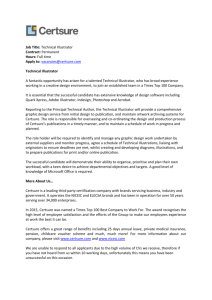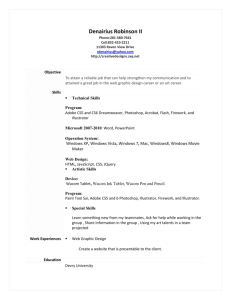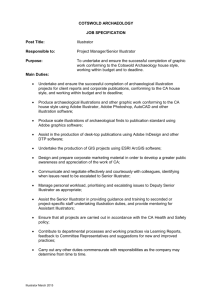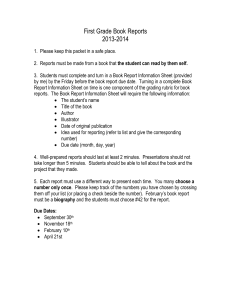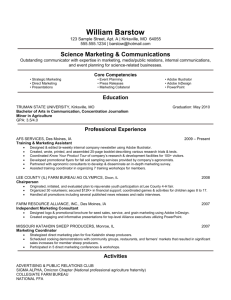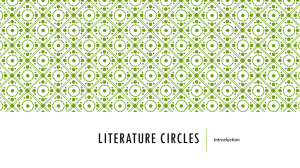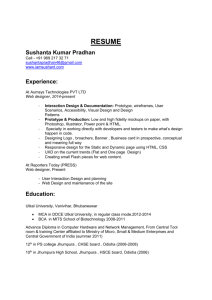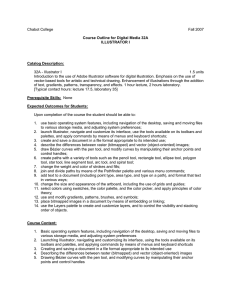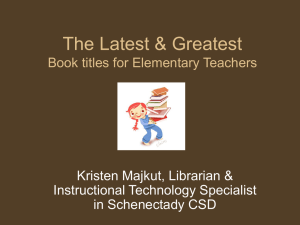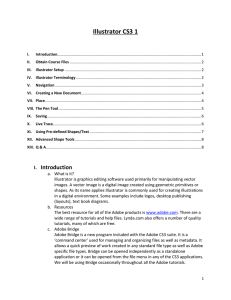tech_illistrator_2.1..
advertisement
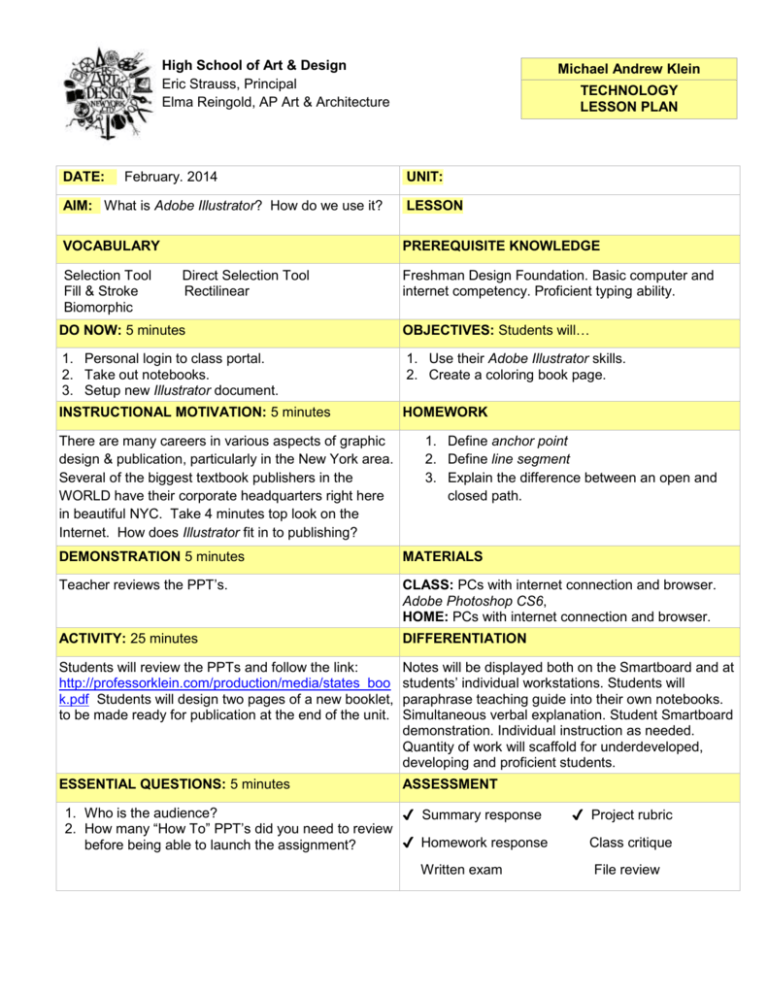
High School of Art & Design Eric Strauss, Principal Elma Reingold, AP Art & Architecture DATE: February. 2014 Michael Andrew Klein TECHNOLOGY LESSON PLAN UNIT: AIM: What is Adobe Illustrator? How do we use it? LESSON VOCABULARY PREREQUISITE KNOWLEDGE Selection Tool Fill & Stroke Biomorphic Direct Selection Tool Rectilinear Freshman Design Foundation. Basic computer and internet competency. Proficient typing ability. DO NOW: 5 minutes OBJECTIVES: Students will… 1. Personal login to class portal. 2. Take out notebooks. 3. Setup new Illustrator document. 1. Use their Adobe Illustrator skills. 2. Create a coloring book page. INSTRUCTIONAL MOTIVATION: 5 minutes HOMEWORK There are many careers in various aspects of graphic design & publication, particularly in the New York area. Several of the biggest textbook publishers in the WORLD have their corporate headquarters right here in beautiful NYC. Take 4 minutes top look on the Internet. How does Illustrator fit in to publishing? 1. Define anchor point 2. Define line segment 3. Explain the difference between an open and closed path. DEMONSTRATION 5 minutes MATERIALS Teacher reviews the PPT’s. CLASS: PCs with internet connection and browser. Adobe Photoshop CS6, HOME: PCs with internet connection and browser. ACTIVITY: 25 minutes DIFFERENTIATION Students will review the PPTs and follow the link: http://professorklein.com/production/media/states_boo k.pdf Students will design two pages of a new booklet, to be made ready for publication at the end of the unit. Notes will be displayed both on the Smartboard and at students’ individual workstations. Students will paraphrase teaching guide into their own notebooks. Simultaneous verbal explanation. Student Smartboard demonstration. Individual instruction as needed. Quantity of work will scaffold for underdeveloped, developing and proficient students. ESSENTIAL QUESTIONS: 5 minutes ASSESSMENT 1. Who is the audience? ✔ Summary response 2. How many “How To” PPT’s did you need to review ✔ Homework response before being able to launch the assignment? ✔ Written exam ✔ Project rubric ✔ Class critique ✔ File review NYS ART STANDARDS ✔ 1. Creating art Indicators A-D ✔ 2. Materials Indicators A-C 3. Analysis Indicators A-C 4. Personal & Cultural Communication Indicators A-C NYC BLUEPRINT ✔ 1. Art Making Media Technology 2D Applied Design Awareness of Careers Goals and Plans ✔ 2. Art Literacy ✔ 3. Making Connections ✔✔ 4. Community & Cultural 5. Life-Long Learning CCSS ELA LITERACY CCRA.W Text Types and Purposes 1. Write arguments to support claims in an analysis of substantive topics or texts using valid reasoning and relevant and sufficient evidence. 2. Write informative/explanatory texts to examine and convey complex ideas and information clearly and accurately through the effective selection, organization, and analysis of content. ✔ 3. Write narratives to develop real or imagined experiences or events using effective technique, well-chosen details and well-structured event sequences. Production and Distribution of Writing 4. Produce clear and coherent writing in which the development, organization, and style are appropriate to task, purpose, and audience. ✔ 5. Develop and strengthen writing as needed by planning, revising, editing, rewriting, or trying a new approach. ✔✔ 6. Use technology, including the Internet, to CDOS ✔ 1: Career Development ✔ 2: Integrated Learning 3a: Universal Foundation Skills ✔ 3b: Career Majors CCSS MATH 1. Make sense of problems and persevere in solving them. ✔ 2. Reason abstractly and quantitatively. ✔ 3. Construct viable arguments and critique the reasoning of others. ✔ 4. Model with mathematics. ✔ 5. Use appropriate tools strategically. ✔ 6. Attend to precision. ✔ 7. Look for and make use of structure. ✔ 8. Look for and express regularity in repeated reasoning. produce and publish writing and to interact and collaborate with others. Research to Build and Present Knowledge ✔ 7. Conduct short as well as more sustained research projects based on focused questions, demonstrating understanding of the subject under investigation. ✔ 8. Gather relevant information from multiple print and digital sources, assess the credibility and accuracy of each source, and integrate the information while avoiding plagiarism. ✔ 9. Draw evidence from literary or informational texts to support analysis, reflection, and research. Range of Writing ✔ 10. Write routinely over extended time frames (time for research, reflection, and revision) and shorter time frames (a single sitting or a day or two) for a range of tasks, purposes, and audiences.


